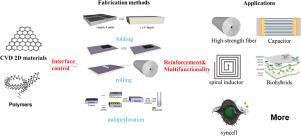Progress in Polymer Science ( IF 26.0 ) Pub Date : 2021-01-14 , DOI: 10.1016/j.progpolymsci.2021.101360 Ziyang Zhang , Jigang Du , Jiaxu Li , Xiaodong Huang , Ting Kang , Chi Zhang , Song Wang , Olayemi Oluwatosin Ajao , Wen-Jun Wang , Pingwei Liu

|
The use of nanomaterials with exotic mechanical and functional properties to reinforce otherwise softer and inert polymers or resins promises the development of high-performance and highly functional composite materials for advanced applications. Polymeric materials serving as matrices or substrates can translate the superior properties of different nanomaterials from nanoscale to macroscale, holding the potential to move nanomaterials from the research laboratory to tangible technological applications that revolutionize the broad plastics industry. However, even after nearly 30 years of innovative and groundbreaking research, various technical challenges still exist such as controlling the dispersion of nanomaterials in the polymer matrix during processing and the need for new synthetic concepts and processing strategies [1]. Emerging trends in 2D nanotechnology and the recent development of certain 2D materials (e.g., large-area 2D sheets and 2D heterostructures) may provide for major advancements in the field of polymer nanocomposites. The use of 2D sheets as fillers provides a means of precisely positioning nanomaterials into/onto polymer matrices/substrates with precise structural control at an atomic level, a precise control of the surface/interface layer and the distances in between the nanoinclusions, all of which are not feasible with traditional polymer nanocomposite materials. The 2D filler components have extremely high aspect ratios, which provides for maximum reinforcement at exceedingly small volume fractions. They also provide ‘multifunctional property enhancement’ and, for example, can contribute specific photoelectric or electronic functionality and mechanical reinforcement. This contribution reviews recent advances in 2D materials-based polymer nanocomposites. First, important synthetic techniques for 2D nanomaterials such as chemical vapor deposition growth and wet-chemistry are presented. Subsequently, strategies for the surface modification of 2D sheets with small molecules and polymers as well as processes for the manufacturing of polymer nanocomposites with aligned 2D inclusions are reviewed. The mechanisms of physical property enhancement are discussed and applications across a range of technology areas are presented. Finally, the challenges as well as opportunities for research in this emerging area of nanocomposite science and engineering are commented on. It is hoped that the unified perspective presented in this review will enable readers to make contributions to this exciting and rapidly advancing field.
中文翻译:

具有对齐二维材料的聚合物纳米复合材料
具有奇异的机械和功能特性的纳米材料的使用可增强否则较软和惰性的聚合物或树脂,有望开发出用于高级应用的高性能和高功能复合材料。用作基质或基材的聚合材料可以将不同纳米材料的优越性能从纳米级转换为宏观级,从而具有将纳米材料从研究实验室转移到有形技术应用的潜力,从而彻底改变了整个塑料行业。然而,即使经过近30年的创新和开创性研究,仍然存在各种技术挑战,例如在加工过程中控制纳米材料在聚合物基质中的分散以及对新的合成概念和加工策略的需求[1]。2D纳米技术的新兴趋势以及某些2D材料(例如,大面积2D薄片和2D异质结构)的最新发展可能会为聚合物纳米复合材料领域带来重大进展。使用2D薄片作为填充物提供了一种将纳米材料精确定位到聚合物基体/基材中/之上的方法,并具有原子级的精确结构控制,表面/界面层的精确控制以及纳米内含物之间的距离,所有这些传统的聚合物纳米复合材料是不可行的。2D填料组分具有极高的长宽比,可在极小的体积分数下提供最大的增强作用。它们还提供“多功能属性增强”功能,例如,可以提供特定的光电或电子功能以及机械增强。该贡献回顾了基于2D材料的聚合物纳米复合材料的最新进展。首先,介绍了用于2D纳米材料的重要合成技术,例如化学气相沉积生长和湿化学。随后,综述了用小分子和聚合物对2D薄片进行表面改性的策略,以及制备具有对齐2D夹杂物的聚合物纳米复合材料的方法。讨论了物理性能增强的机制,并介绍了在一系列技术领域中的应用。最后,对纳米复合科学与工程这一新兴领域的研究挑战与机遇进行了评论。











































 京公网安备 11010802027423号
京公网安备 11010802027423号